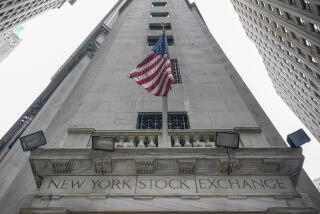Bailout Plan Seen Erasing Third of S&Ls; : Capital Requirement Expected to Cause Massive Shakeout
- Share via
WASHINGTON — President Bush’s plan to bail out foundering savings and loan institutions will trigger a massive industry shakeout that will wipe out a third to a half of today’s S&Ls;, a growing number of financial experts believe.
Bush’s proposal has the immediate goal of liquidating about 350 insolvent thrift institutions and making good on federal insurance of deposits up to $100,000.
In addition, however, analysts expect more than 1,000 weak but currently afloat S&Ls; to disappear--either swallowed by other thrifts, bank-holding companies and non-financial corporations or forced to shut down altogether.
Only 2,000 May Remain
The savings industry, destined to become not much more than a carbon copy of the banking business, may be left with 2,000 S&Ls; or even fewer.
Economist Allan Meltzer of Carnegie-Mellon Institute in Pittsburgh, Pa., compares the S&L; situation today to a typical freshman class at college. “Look to the right of you, look to the left of you,” Meltzer tells his students. “One of the three of you will not survive.”
Responsibility for this massive consolidation of the highly fragmented U.S. lending business will go to a key provision of the Bush proposal--a requirement that S&Ls; maintain capital reserves roughly equal to at least 6% of their assets by mid-1991, compared to only 3% now.
Banks also will be required to meet the new test, which, ultimately, will force all financial institutions to hold a minimum of 8% of their assets in readily available sources of cash, such as equity, preferred stock and retained earnings, to cover potential losses from bad loans. The uniform standards are supposed to be fully in place by the end of 1992.
For most Americans, the change might mean a shift to a different institution for saving and borrowing. But there still should be plenty of available sources for home mortgages and credit cards.
Benefits for Home Loans
Indeed, home loans will enjoy a special benefit under the new risk-based capital requirements, because banks and thrifts will need to hold only half as much capital to back mortgages on homes and apartments of up to four units as they will for most other loans.
But for many home builders and real estate developers, the new rules could spell the end of the cozy relationship that they have built over the years with local thrifts.
The Bush Administration insists that requiring the thrifts to roughly double their own capital is the minimum necessary to prevent another collapse of the industry in the future. Unless they are forced to put more of their own capital at risk, Administration officials point out, federally insured S&Ls; will have no reason to curb dangerous lending practices.
“Imposing the higher capital standard is the only way we can avoid sowing the seeds for another disaster,” agrees Robert Litan, a banking industry analyst at the Brookings Institution. “This is the key to making the plan work.”
Bush’s proposal for raising the capital requirement for S&Ls; may not emerge from Congress intact. But whatever compromise he reaches with Congress almost surely will include provisions designed to force the thrift industry to shore itself up and prevent a repeat of the current crisis.
“One of the great scandals is the weak capitalization of the thrift industry,” says Iowa Rep. Jim Leach, a senior Republican on the House Banking, Finance and Urban Affairs Committee.
Industry Up in Arms
Lobbyists for the once-politically sacrosanct thrift industry are up in arms over the Bush Administration’s unspoken plans to put hundreds of weak savings institutions out of business. “They will fight this to the death,” says Kenneth Guenther, head of the Independent Bankers Assn. of America, which represents small banks.
Death it may be. Lawmakers, once beholden to the thrift industry because of its widespread local political clout and its mountains of campaign contributions, are starting to demonstrate much greater independence. The electoral defeat last November of former House Banking Committee Chairman Fernand J. St Germain (D-R.I.) removed a major obstacle to reform.
Under pressure from the thrift industry, the White House has indicated that it might be willing to make the capital requirements temporarily easier to meet. Nonetheless, whatever new rules emerge are expected to touch off nothing less than a Darwinian struggle for survival of the fittest S&Ls.;
“If that means the difference between life and death for an industry, then you’re describing a marginal industry,” says former Treasury Undersecretary George Gould. “Maybe the free market is saying you should let it die.”
Lending May Be Curtailed
U.S. banks are going to be under pressure from the similar capital requirements already approved by the Federal Reserve. Although the banking industry as a whole is already close to meeting the standards for 1991, a number of big banks are going to have to pull in their horns and reduce the pace of their lending to ensure that they do not fall back below the line.
That will open the door even wider to well-capitalized foreign banks, particularly from Japan. Strong foreign banks, already well established in such U.S. beachheads as California, are expected to be at the forefront of the merger and acquisition frenzy that is already beginning to sweep over the long-sheltered American financial system.
“As we move toward tougher capital requirements, the response of most managers will be to shrink their assets to conform with their existing capital base rather than try to raise new funds,” says Jerry Jordan, chief economist at First Interstate Bank in Los Angeles. “A lot of foreign banks have such deep pockets, though, that they don’t have that problem. As a result, we’re going to be giving more of the domestic banking market to foreigners.”
Analysts agree that foreign banks, which must meet the same standards as U.S. banks if they are to operate here, will make further inroads in the business of making loans to American business and consumers.
Cites U.S. Debtor Position
“It’s inevitable that those who have the most money will get ahead in this business,” says Litan of Brookings. “Of course, given the net debtor position of the United States, we should be happy to get the money from wherever we can.”
Regardless of whatever compromise emerges from Congress, analysts are convinced that the thrift industry has no choice but to shrink. “We’re clearly headed toward consolidation of a large portion of the thrift industry,” says Paul Horvitz, a banking expert at the University of Houston.
And Catherine England, a financial expert at the free-market-oriented Cato Institute here, predicts: “We’ll see a lot smaller thrift industry and one that looks increasingly like the banking industry. It will be harder and harder to tell them apart.”
But just because the number of thrifts decline sharply, housing finance will not necessarily dry up as well.
“The rationale for the system has largely evaporated, but much of what they do is also done by mortgage bankers,” says Meltzer, who served as a White House economic consultant during the last year of Ronald Reagan’s presidency. “The only exception is ARMs (adjustable rate mortgages)--there still is a market for S&Ls; to put some of those together.”
Sees Void Being Filled
Albert Wojnilower, a senior adviser to First Boston Corp. in New York, says that any void left in housing finance will quickly be filled. “Given the evolution of the technology of finance,” he says, “you no longer need a local institution to make a local mortgage.”
Wojnilower sees the decline of the savings and loan industry as part of a trend stretching back to the early 1970s, when the first money-market funds sprang up as deposit-collecting rivals to the traditional thrift institutions.
But in the end, he contends, the nation’s financial system will emerge from the debacle in better shape than before.
“I don’t see this as a case of lambs thrown to the wolves,” he says. “On the contrary, the others will be better off because the weak ones have been eliminated.”
More to Read
Inside the business of entertainment
The Wide Shot brings you news, analysis and insights on everything from streaming wars to production — and what it all means for the future.
You may occasionally receive promotional content from the Los Angeles Times.










